Imagine you’re craving pizza and searching online for the best spot in town. You find two restaurants—one with dozens of glowing five-star reviews and another with only a few mixed ratings. Which one would you choose?
This simple decision happens every single day across the world. Online reviews shape our choices more than we realize, whether it’s about picking a restaurant, buying a cool trending gadget, or booking a hotel.
A single positive comment can grow your business, but a bunch of bad ones can drive customers away.
But just how much do reviews influence people? And what do the numbers say about their power?
Let’s dive into the online review stats and find why they matter more than ever.
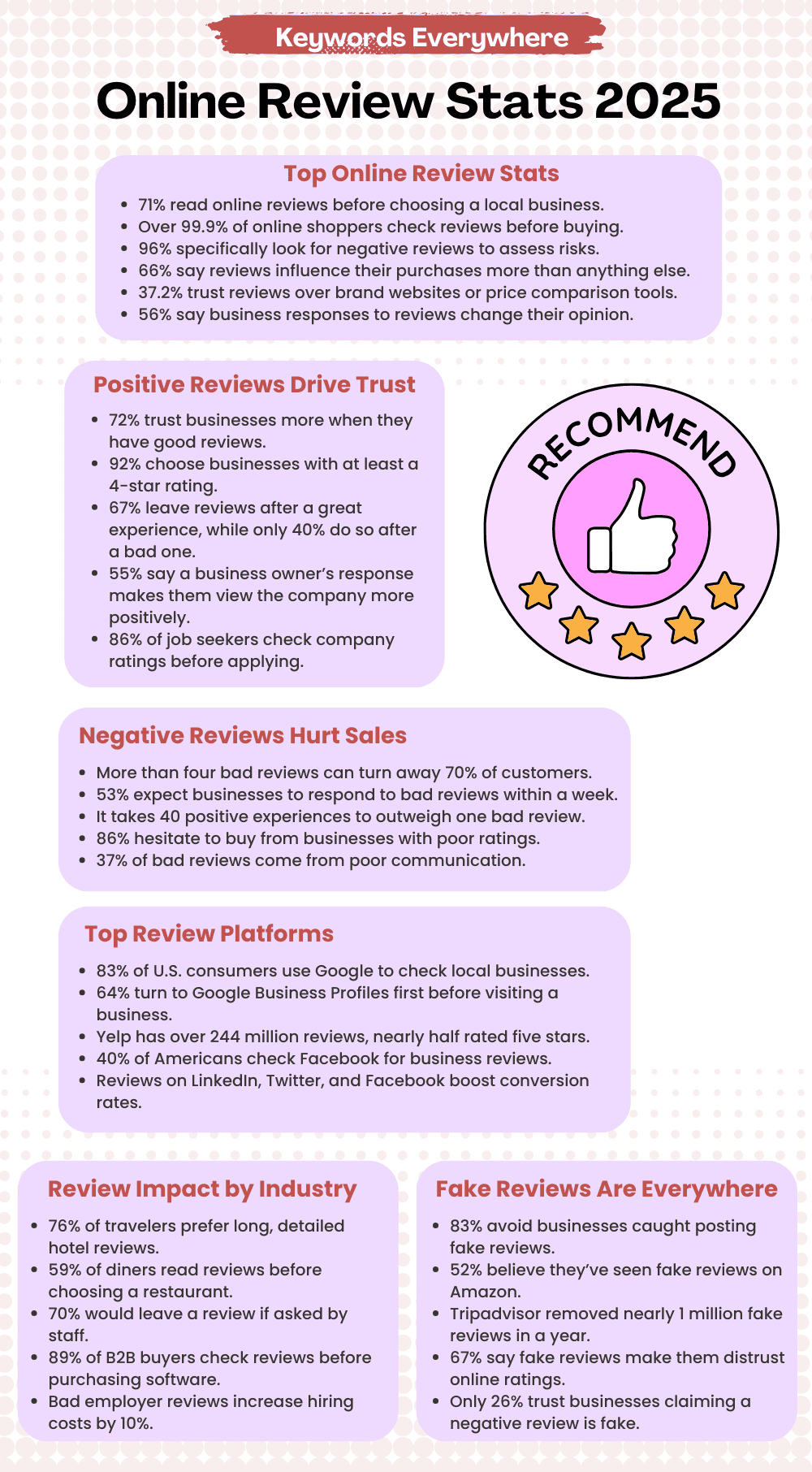
Top Online Review Stats
Online reviews have become a big and important part of decision-making for consumers. They influence consumer trust, brand reputation, and even your search rankings.
But just how big is their impact? Here are some top online review stats to reveal how reviews shape businesses and why they matter more than ever.
1. About 71% of consumers read online reviews when researching local businesses, while only 4% say they never check reviews at all.
2. Nearly everyone shopping online reads reviews—over 99.9% of customers do. And interestingly, 96% specifically seek out negative reviews to see potential drawbacks.
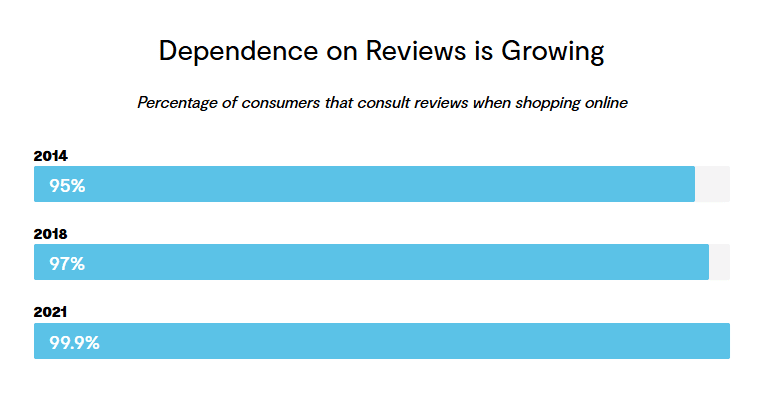
Dependence on online reviews is growing
3. 7 in 10 Americans say they rarely visit a new business without reading the online reviews first.
4. 66% of consumers say that online reviews “often” or “very often” influence their purchase decisions—more than any other source of information.
5. Customers consider businesses with a rating of at least 3.3 stars out of 5 as acceptable. Even a 3-star rating might not be good enough in today’s competitive market.
6. Keywords Everywhere reveals that searches for “reviews” on Google have remained steady for the past five years. This shows that people still rely on online reviews—and will continue to use them—before making a purchase.
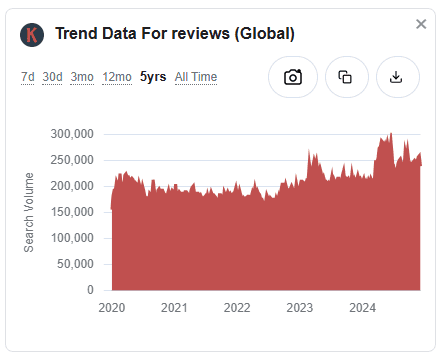
7. 37.2% of internet users aged 16 to 64 say online reviews are their primary source of information for brand research, ranking higher than product or brand websites (33.3%) and price comparison sites (26.8%).
8. 94% of local businesses that invest in reputation management tools see a positive return on investment.
9. Consumers are becoming more skeptical of fake reviews. 93% of Facebook users, 90% of Google users, and 89% of Amazon shoppers are wary of dishonest feedback on these platforms.
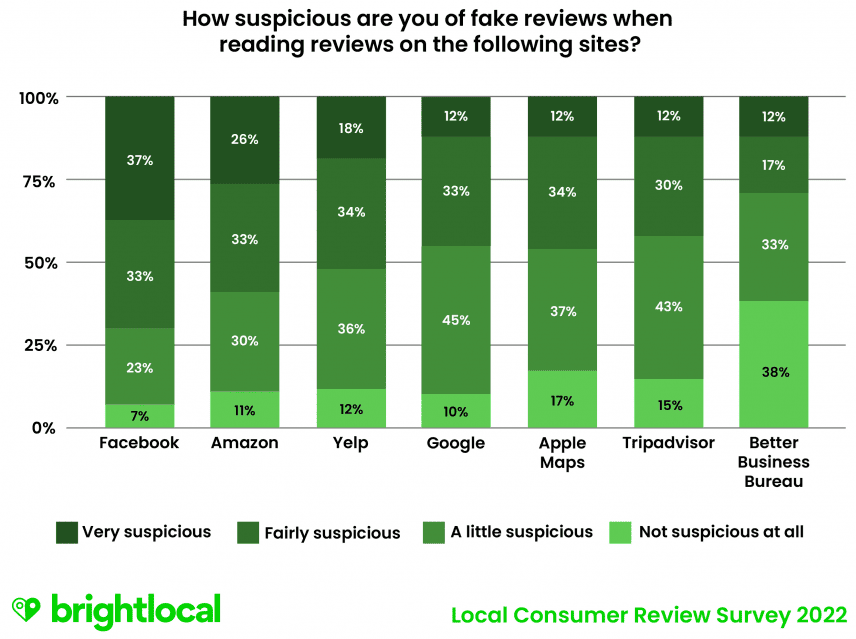
Percentage of customers suspicious of fake reviews
Positive Online Review Stats
If you see a product with a five-star rating and hundreds—or even thousands—of positive reviews, chances are you’ll feel confident buying it. A glowing review does more than just make a business owner smile—it boosts sales, attracts new customers, and strengthens brand loyalty.
In a world where trust is everything, positive online reviews act as digital word-of-mouth marketing. Let’s look at the positive online review stats to show just how powerful they can be.
10. 72% of people say that positive reviews increase their trust in a local business, and 92% of consumers are likely to use a business if it has at least a 4-star rating.
11. 67% of consumers are willing to leave a review after having a positive experience, while only 40% would do so after a negative one. This shows that the potential benefits of collecting reviews far outweigh the risks.
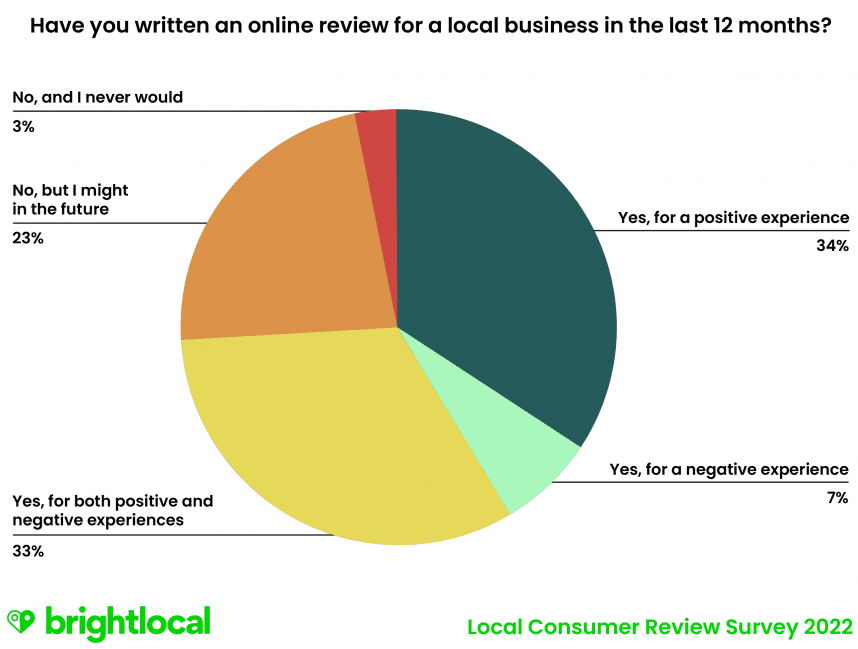
Percentage of people who have written an online review for a local business
12. Just 7% of consumers leave reviews only for negative experiences, while 34% leave reviews exclusively for positive ones.
13. 61% of users say they would leave a review after a positive experience if the business went above and beyond. Meanwhile, 43% would write a review if a negative experience was turned into a positive one.
14. Large chains often struggle to generate reviews, even after positive interactions. However, 22% of consumers say a business being part of a chain wouldn’t impact their decision to leave a review.
15. The top three factors that make reviews impactful for potential customers are:
- A well-written review describing a positive experience (75%).
- A high star rating (58%).
- A response from the business owner (55%).
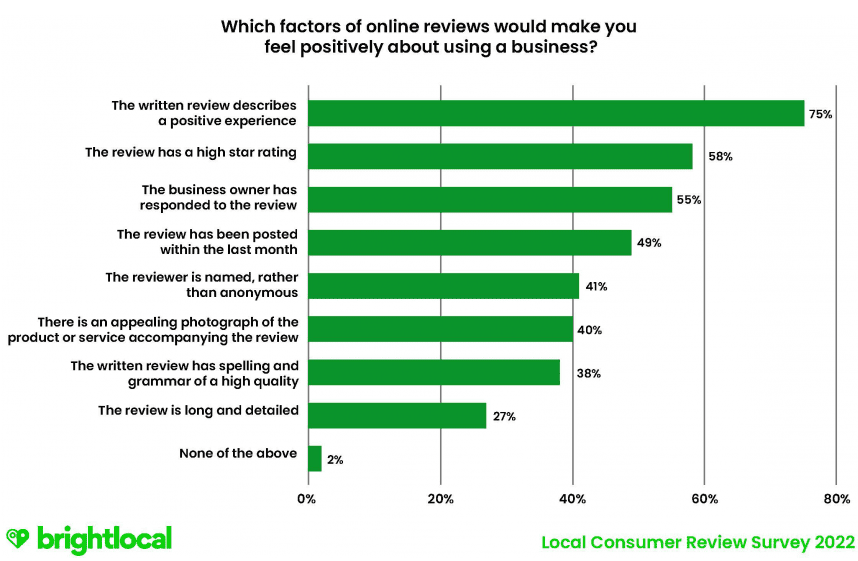
Factors of reviews that matter most to consumers
16. 55% of consumers say a business owner’s response to reviews makes them feel more positive about the business—just 3% less than those who value a high star rating. This means that responding to reviews is nearly as important as maintaining a strong rating.
17. 86% of employees and job seekers research company ratings and reviews before applying for a job. Positive reviews can give all businesses a competitive edge in attracting top talent.
Negative Online Review Stats
A single negative review might seem harmless, but when bad feedback piles up, it can completely damage a company’s reputation and drive potential customers away.
Buyers trust reviews as much as personal recommendations so even a few bad ones can make a big difference. Here’s what the data says about the impact of negative online reviews.
18. Having more than four negative reviews on your Google Business Profile can cause you to lose up to 70% of potential customers.
19. 53% of buyers expect businesses to respond to negative feedback within a week. A prompt and thoughtful response can help reduce the damage caused by bad reviews.
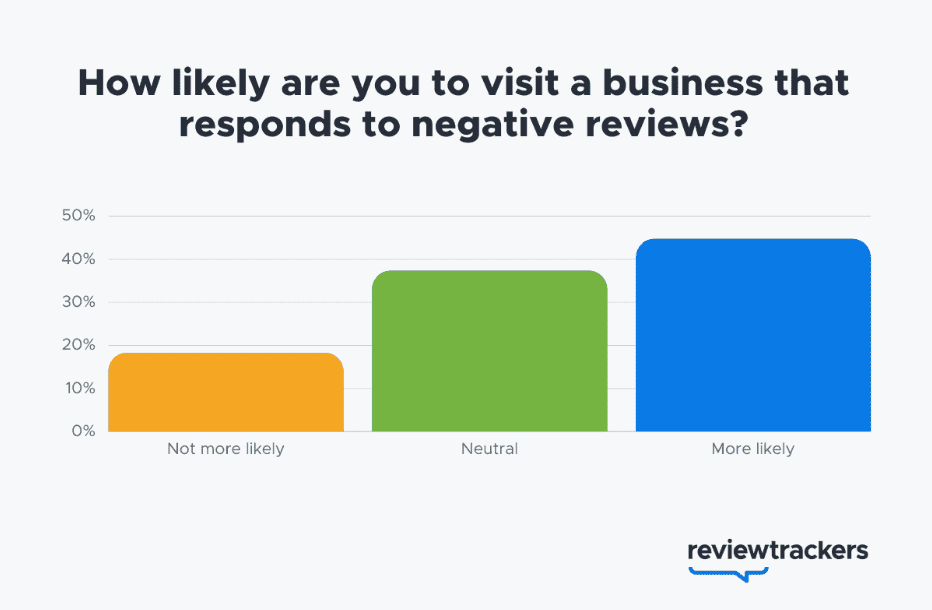
How likely customers visit a business that responds to reviews
20. Negative reviews aren’t always bad for business—82% of people actively seek them out to get a balanced view of a product or service.
21. 69% of shoppers regularly look for negative reviews. Millennials (38%) and Gen Z (38%) are more likely to do so compared to Gen X (33%) and Boomers (28%).
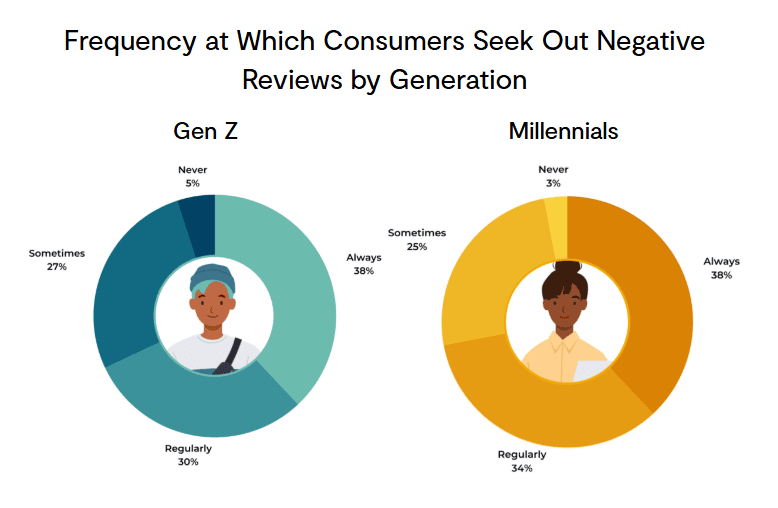
Gen Z and Millennials seek out negative reviews more than any other generation
22. It takes around 40 positive experiences to offset the impact of just one negative review.
23. Customers spend up to 31% more on products with excellent reviews, but 86% hesitate to purchase from businesses with poor ratings.
24. If you’re wondering why your business is getting lots of negative reviews, know this: Poor communication is responsible for 37% of negative reviews.
25. Products with average rating between 4.2 and 4.5 stars sell the best. A perfect 5-star rating often seems too good to be true.
26. 62.4% of shoppers who use the star rating filter on review pages specifically look for one-star reviews. Surprisingly, these shoppers still convert at a rate 108.8% higher than the average visitor.
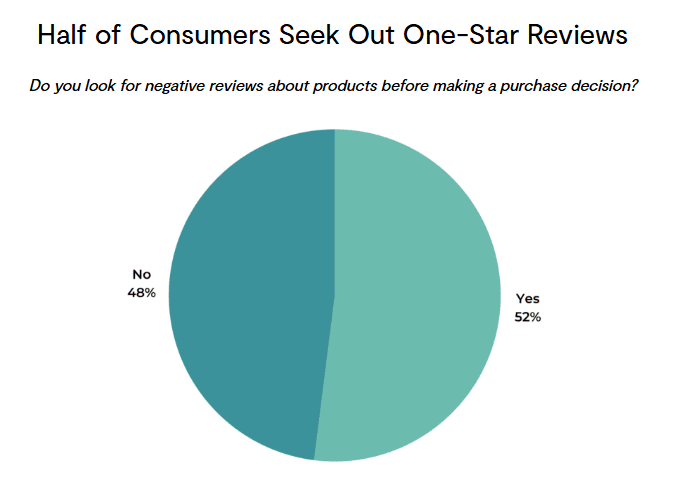
Majority of consumers seek out one star content
Online Review Platform Stats
Not all online reviews are created equal—where they’re posted matters just as much as what they say. From Google to Yelp to Facebook, different platforms influence consumers in different ways.
Understanding how these platforms work can help your business make the most of its online presence. Let’s dive into the online review stats behind the biggest sites.
27. 83% of US consumers use Google to evaluate local businesses, making it the only platform used by more than half of surveyed consumers.
28. The percentage of people using Yelp for online reviews has dropped from 53% in 2022 to 44% in 2025, but it still remains one of the top three most-used review platforms.
29. In 2025, 40% of American consumers checked Facebook for business reviews, followed by YouTube (34%) and Instagram (31%) as other popular platforms.
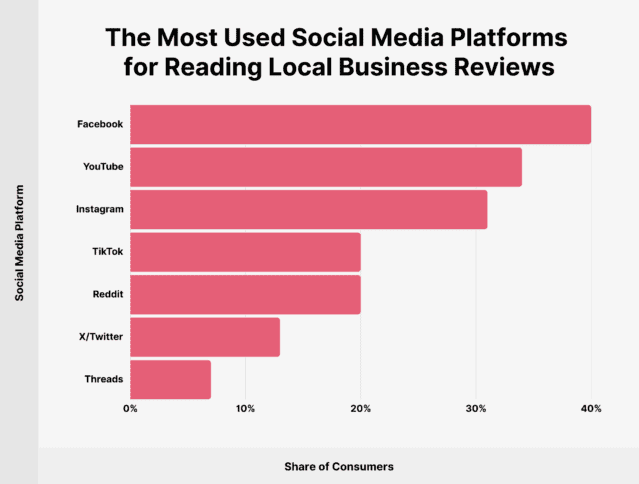
Most used social media platforms for reading reviews
30. Reviews shared on social media drive 5.3x higher conversion rates on LinkedIn, 8.4x higher on Twitter, and 40x higher on Facebook.
31. Yelp has amassed over 244 million reviews, with 77% of them being three stars or higher and nearly half (48%) giving a full five-star rating.
32. Of five major review sites, 45% of consumers check Yelp before visiting a business.
33. Nearly 100% of Yelp visitors have made a purchase from a business listed on the platform.
34. 64% of people turn to Google Business Profiles first when looking up online reviews before visiting a business.
35. According to Keywords Everywhere, the term “Google review” gets over 600,000 searches per month. Related search terms also show high volumes, which means people consistently turn to Google for reviews before making decisions.
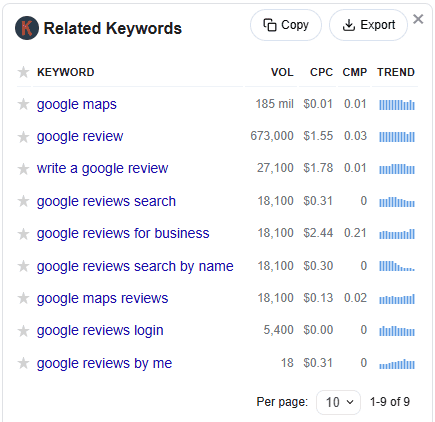
36. Google Business listings with photos are seen as twice as reputable and get 35% more clicks than those without images.
37. After Google and Yelp, Facebook is the third most popular review platform, influencing 52% of both online and offline purchases.
38. 1 in 3 Facebook users worldwide relies on the platform for recommendations and reviews.
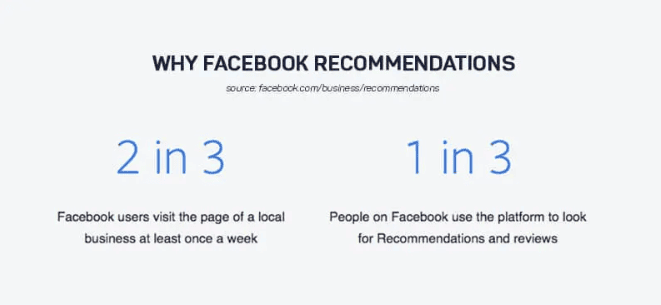
Why Facebook recommendations matter
Industry-Specific Online Review Stats
Did you know that only 49% of potential patients check Google reviews for healthcare providers, while nearly all (96%) customers consider online reviews when choosing a residential home services provider?
Online reviews don’t impact every industry the same way. Reviews can make or break a business in some sectors (like hospitality and healthcare), while in others, their influence is somewhat moderate.
Here are some important online review stats for different industries:
39. TripAdvisor hit one billion reviews in February 2022. The site, launched in 2000, took 17 years to reach its first billion but only five more years to double that number.
40. Sustainability is a hot topic in Expedia’s guest reviews. Travelers frequently mention single-use plastics and recycling when sharing their experiences.
41. Travelers want details. 76% prefer longer reviews when choosing a hotel, and 68% are more likely to book after reading an in-depth review.
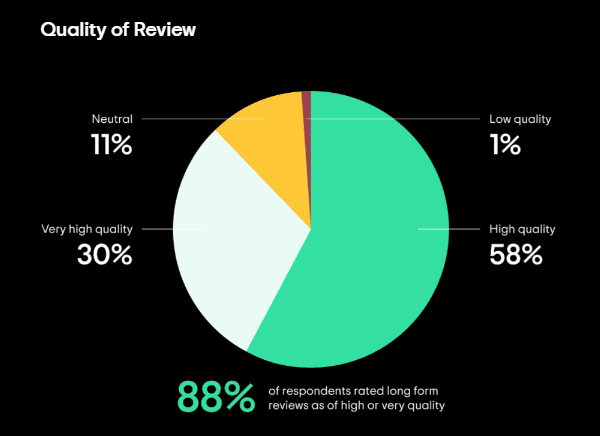
Long form reviews influences the decision of travelers
42. On GetYourGuide.com, 68% of travelers say they steer clear of attractions that seem overly commercialized, and 41% will skip an entire destination if they think it’s too touristy.
43. 59% of people consider online reviews when choosing a doctor, dentist, or other healthcare provider.
44. 36% of people read online reviews before booking a salon appointment, while 25% also check feedback from professionals in the field.
45. High prices and poor performance are the two main reasons behind negative reviews for auto repair shops.
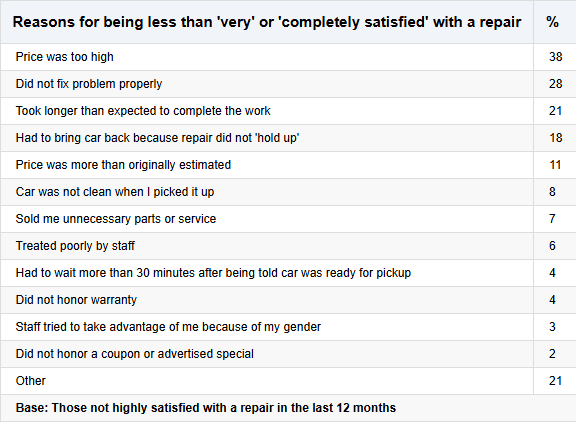
Reasons behind negative reviews for automotive industry
46. Electric vehicle (EV) reviews tend to receive more 1-star ratings than the average automobile review.
47. 59% of diners read online reviews before deciding where to eat, and 70% say they would leave a review if asked by a server or manager.
48. Nearly 60% of people rely on online reviews when choosing a lawyer, and about 19% of millennials would even consider a lawyer without any online reviews.
49. Employers with negative online reviews spend 10% more per hire, and 57% of job seekers avoid companies with bad ratings.
50. 89% of B2B buyers who use review sites say they always or often check them before purchasing business software.
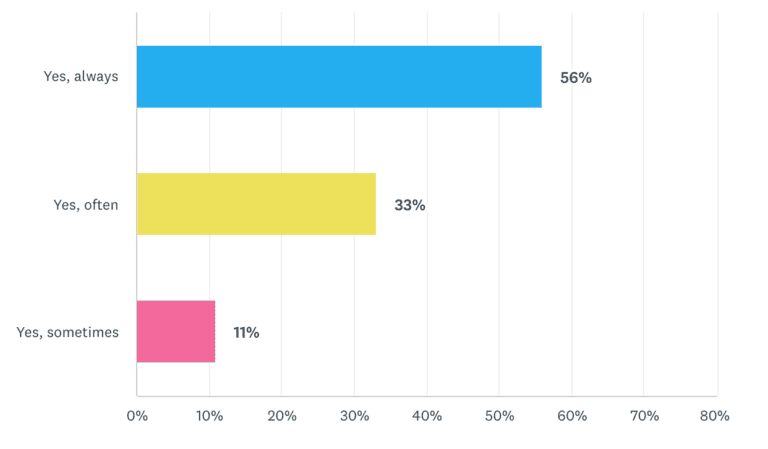
B2B buyers check reviews before purchasing
Fake Online Review Stats
Not everything you read online is true, and the same goes for reviews. While customer feedback is meant to help people make informed decisions, fake reviews have flooded the internet—some boosting ratings, others tearing down competitors.
Businesses buy fake praise, rivals leave false complaints, and consumers are left wondering who to trust.
But can consumers tell the difference? And how big is the problem? These online review stats reveal the surprising truth about fake reviews.
51. 83% of people who read online reviews say they would avoid a business if they found out it had engaged in posting fake or paid reviews.
52. The top three reasons consumers suspect a review might be fake are:
- The review is overly positive and full of excessive praise (45%).
- There are multiple reviews with nearly identical wording (40%).
- The reviewer is anonymous or uses an obviously fake name (38%).

How consumers spot fake reviews
53. Only 26% of consumers say that if a business owner responds to a review and claims it’s fake, it would make them question the review’s authenticity.
54. 62% of consumers believe they have seen a fake review for a local business in the past year, while only 9% are confident they haven’t come across any.
55. The top three platforms where consumers are most certain they have encountered fake reviews in the past year are:
- Amazon (52%)
- Google (50%)
- Facebook (37%)
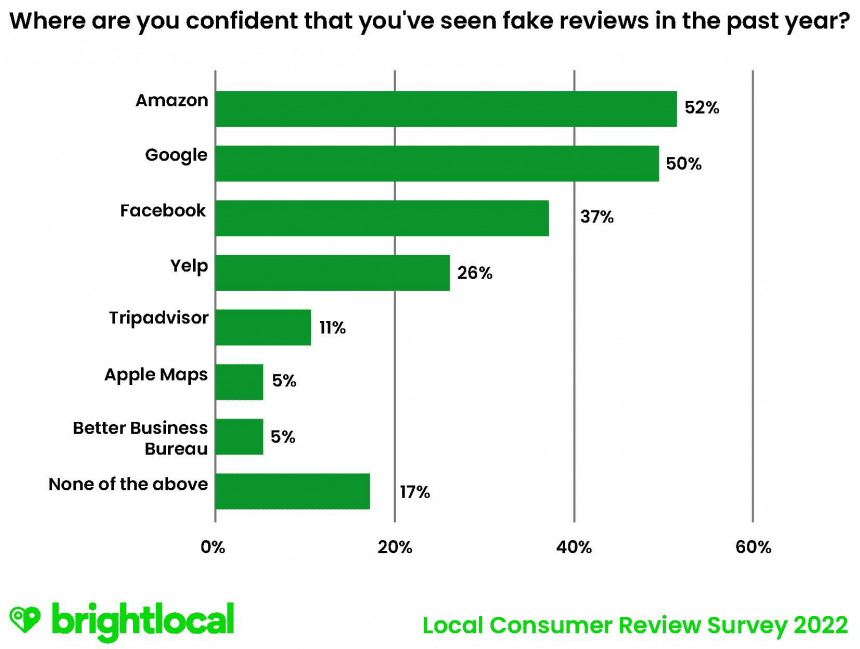
Platforms where customers see fake reviews
56. Tripadvisor had to remove nearly one million fake reviews over the last 12 months. However, only 11% of respondents in BrightLocal’s survey felt they had seen a fake review on the platform during the same period.
57. 67% of consumers agree that the presence of fake reviews and fake reviewers makes them distrust online reviews in general.
Online Review Management Stats
Having reviews is one thing, but managing them effectively is another.
Responding to feedback, addressing complaints, and encouraging happy shoppers to leave online reviews can make a huge difference in how a business is perceived.
The numbers show why businesses need a solid review management strategy.
58. 56% of consumers say their opinion of a business can change depending on how the company responds to reviews.
59. 89% of consumers expect businesses to reply to their reviews, and 63% want a response within three days.
60. 70% of customers are more likely to leave a review if they see that a business actively responds to feedback.
61. Nearly 40% of people who leave a bad review say all they really want is an apology from the business.
62. Shockingly, 75% of businesses don’t respond to negative reviews, missing out on a huge opportunity. Companies that reply to at least 25% of their reviews see 35% higher earnings compared to those that stay silent.
63. Customers spend nearly 50% more at businesses that engage with their online reviews.
64. Letting potential customers read negative reviews and responses can boost conversions by 85%.
65. A staggering 94% of consumers say that a bad review has been enough to make them avoid a business entirely.
Conclusion
If there’s one thing you should take away from these online review stats, it’s this—reviews matter a lot.
Whether you run a small local shop or a big online brand, people are checking what others say about you before making a decision.
A strong review profile can boost your credibility, bring in more customers, and even increase sales. On the flip side, too many bad reviews (or ignoring them) can turn people away fast.
One thing I always recommend? Don’t just collect reviews—engage with them. A quick response can show your future and current customers that you actually care.
Plus, businesses that actively respond to reviews tend to make more money.


